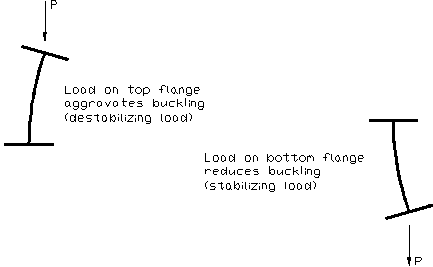Load height factor
The load height factor kl relates to the point of application of gravity loads as specified by the load height position (see also "Load height position" in Steel member design data). It is always 1.0 if the loads are applied at or below the member's shear centre, however for non-vertical members it can exceed 1.0 if the top of the member is subjected to a downwards load that causes a destabilizing effect.

If the top of the member is loaded within the segment then kl = 1.2 for all codes, except AS4100 and NZS3404 where kl = 1.4 if both ends of the segment are fully, partially or laterally restrained or kl = 2.0 if either end is unrestrained.
If the top of the member is not loaded within the segment but shear force is detected at the end of a segment that is unrestrained then kl = 1.2 for all codes, except AS4100 and NZS3404 where kl = 2.0.
If you specify the load height position as "Shear centre" then kl=1.0 regardless of the loading condition.
For vertical members, kl=1.0 regardless of the load height position setting or the loading condition.
![]() The definition of "top of the member" in the above discussion is the side or flange that is physically on top (ie. furthest from the ground). This definition is different to "top flange" used elsewhere in this manual which can actually be on the bottom if you have rotated the member about its own axis (eg. if the member is upside down).
The definition of "top of the member" in the above discussion is the side or flange that is physically on top (ie. furthest from the ground). This definition is different to "top flange" used elsewhere in this manual which can actually be on the bottom if you have rotated the member about its own axis (eg. if the member is upside down).